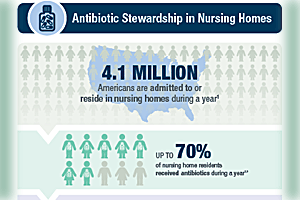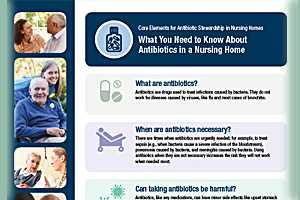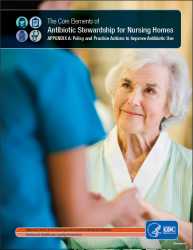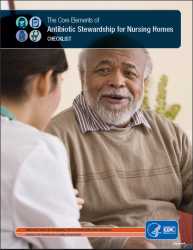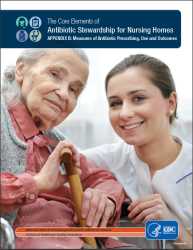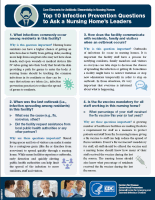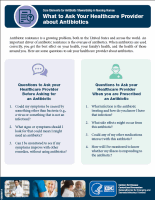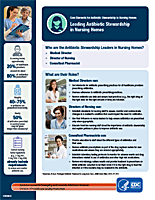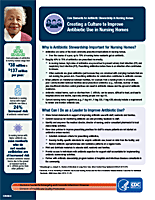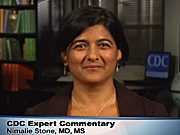The Core Elements of Antibiotic Stewardship for Nursing Homes
The Core Elements of Antibiotic Stewardship for Nursing Homes adapts the CDC Core Elements of Hospital Antibiotic Stewardship into practical ways to initiate or expand antibiotic stewardship activities in nursing homes. Nursing homes are encouraged to work in a step-wise fashion, implementing one or two activities to start and gradually adding new strategies from each element over time. Any action taken to improve antibiotic use is expected to reduce adverse events, prevent emergence of resistance, and lead to better outcomes for residents in this setting.
Core Elements of Antibiotic Stewardship for Nursing Homes
Introduction
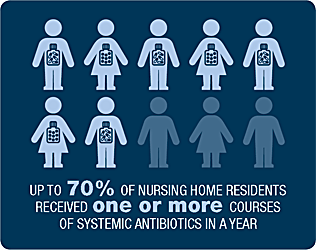 Improving the use of antibiotics in healthcare to protect patients and reduce the threat of antibiotic resistance is a national priority. Antibiotic stewardship refers to a set of commitments and actions designed to “optimize the treatment of infections while reducing the adverse events associated with antibiotic use.” The Centers for Disease Control and Prevention (CDC) recommends that all acute care hospitals implement an antibiotic stewardship program (ASP) and outlined the seven core elements which are necessary for implementing successful ASPs. CDC also recommends that all nursing homes take steps to improve antibiotic prescribing practices and reduce inappropriate use.
Improving the use of antibiotics in healthcare to protect patients and reduce the threat of antibiotic resistance is a national priority. Antibiotic stewardship refers to a set of commitments and actions designed to “optimize the treatment of infections while reducing the adverse events associated with antibiotic use.” The Centers for Disease Control and Prevention (CDC) recommends that all acute care hospitals implement an antibiotic stewardship program (ASP) and outlined the seven core elements which are necessary for implementing successful ASPs. CDC also recommends that all nursing homes take steps to improve antibiotic prescribing practices and reduce inappropriate use.
Antibiotics are among the most frequently prescribed medications in nursing homes, with up to 70% of residents in a nursing home receiving one or more courses of systemic antibiotics when followed over a year. 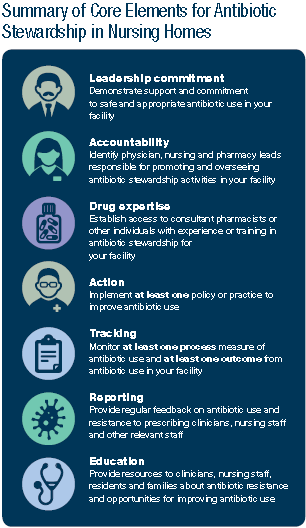 Similar to the findings in hospitals, studies have shown that 40–75% of antibiotics prescribed in nursing homes may be unnecessary or inappropriate. Harms from antibiotic overuse are significant for the frail and older adults receiving care in nursing homes. These harms include risk of serious diarrheal infections from Clostridium difficile, increased adverse drug events and drug interactions, and colonization and/or infection with antibiotic-resistant organisms.
Similar to the findings in hospitals, studies have shown that 40–75% of antibiotics prescribed in nursing homes may be unnecessary or inappropriate. Harms from antibiotic overuse are significant for the frail and older adults receiving care in nursing homes. These harms include risk of serious diarrheal infections from Clostridium difficile, increased adverse drug events and drug interactions, and colonization and/or infection with antibiotic-resistant organisms.
This document adapts the CDC Core Elements of Hospital Antibiotic Stewardship into practical ways to initiate or expand antibiotic stewardship activities in nursing homes. While the elements are the same for both hospitals and nursing homes, the implementation of these elements may vary based on facility staffing and resources. Nursing homes are encouraged to work in a step-wise fashion, implementing one or two activities to start and gradually adding new strategies from each element over time. Any action taken to improve antibiotic use is expected to reduce adverse events, prevent emergence of resistance, and lead to better outcomes for residents in this setting.
Leadership Commitment
Nursing home leaders commit to improving antibiotic use. Facility leadership, both owners and administrators, as well as regional and national leaders if the facility is part of a larger corporation, can demonstrate their support in the following ways:
Write statements in support of improving antibiotic use to be shared with staff, residents and families
Include stewardship-related duties in position descriptions for the medical director, clinical nurse leads, and consultant pharmacists in the facility
Communicate with nursing staff and prescribing clinicians the facility’s expectations about use of antibiotics and the monitoring and enforcement of stewardship policies
Create a culture, through messaging, education, and celebrating improvement, which promotes antibiotic stewardship
Accountability
Nursing homes identify individuals accountable for the antibiotic stewardship activities who have the support of facility leadership:
Empower the medical director to set standards for antibiotic prescribing practices for all clinical providers credentialed to deliver care in a nursing home and be accountable for overseeing adherence. To be effective in this role, the medical director should review antibiotic use data (see Tracking and Reporting section) and ensure best practices are followed in the medical care of residents in the facility.
Empower the director of nursing to set the practice standards for assessing, monitoring and communicating changes in a resident’s condition by front-line nursing staff. Nurses and nurse aides play a key role in the decision-making process for starting an antibiotic. The knowledge, perceptions and attitudes among nursing staff of the role of antibiotics in the care of nursing home residents can significantly influence how information is communicated to clinicians who are deciding whether to initiate antibiotic therapy. Therefore the importance of antibiotic stewardship is conveyed by the expectations set by nursing leadership in the facility.
Engage the consultant pharmacist in supporting antibiotic stewardship oversight through quality assurance activities such as medication regimen review and reporting of antibiotic use data.
Nursing home antibiotic stewardship leads utilize existing resources to support antibiotic stewards’ efforts by working with the following partners:
Infection prevention program coordinator
Infection prevention coordinators have key expertise and data to inform strategies to improve antibiotic use. This includes tracking of antibiotic starts, monitoring adherence to evidence-based published criteria during the evaluation and management of treated infections, and reviewing antibiotic resistance patterns in the facility to understand which infections are caused by resistant organisms. When infection prevention coordinators have training, dedicated time, and resources to collect and analyze infection surveillance data, this information can be used to monitor and support antibiotic stewardship activities.
Consultant laboratory
Nursing homes contracting laboratory services can request reports and services to support antibiotic stewardship activities. Examples of laboratory support for antibiotic stewardship include developing a process for alerting the facility if certain antibiotic-resistant organisms are identified, providing education for nursing home staff on the differences in diagnostic tests available for detecting various infectious pathogens (e.g., EIA toxin test vs. nucleic amplification tests for C. difficile), and creating a summary report of antibiotic susceptibility patterns from organisms isolated in cultures. These reports, also known as antibiograms, help inform empiric antibiotic selection (i.e., before culture results are available) and monitor for new or worsening antibiotic resistance.
State and local health departments
Nursing homes benefit from the educational support and resources on antibiotic stewardship and infection prevention which are provided by the Healthcare-Associated Infection (HAI) Prevention programs at state and local health departments.
Drug Expertise
Nursing homes establish access to individuals with antibiotic expertise to implement antibiotic stewardship activities. Receiving support from infectious disease consultants and consultant pharmacists with training in antibiotic stewardship can help a nursing home reduce antibiotic use and experience lower rates of positive C. difficile tests. Examples of establishing antibiotic expertise include:
Work with a consultant pharmacist who has received specialized infectious diseases or antibiotic stewardship training. Example training courses include the Making a Difference in Infectious Diseases (MAD-ID) antibiotic stewardship course, and the Society for Infectious Diseases Pharmacists antibiotic stewardship certificate program.
Partner with antibiotic stewardship program leads at the hospitals within your referral network.
Develop relationships with infectious disease consultants in your community interested in supporting your facility’s stewardship efforts.
Take Action through Policy and Practice Change to Improve Antibiotic Use
Nursing homes implement prescribing policies and change practices to improve antibiotic use. The introduction of new policies and procedures which address antibiotic use should be done in a step-wise fashion so staff become familiar with and not overwhelmed by new changes in practice. Prioritize interventions based on the needs of your facility and share outcomes from successful interventions with nursing staff and clinical providers. Below are brief descriptions of policy and practice changes. For more details, see Appendix A: Policy and practice actions to improve antibiotic use [PDF – 849 KB].
Policies that support optimal antibiotic use
Ensure that current medication safety policies, including medication regimen review, developed to address Centers for Medicare and Medicaid Services (CMS) regulations are being applied to antibiotic prescribing and use.
Broad interventions to improve antibiotic use
Standardize the practices which should be applied during the care of any resident suspected of an infection or started on an antibiotic. These practices include improving the evaluation and communication of clinical signs and symptoms when a resident is first suspected of having an infection, optimizing the use of diagnostic testing, and implementing an antibiotic review process, also known as an “antibiotic time-out,” for all antibiotics prescribed in your facility. Antibiotic reviews provide clinicians with an opportunity to reassess the ongoing need for and choice of an antibiotic when the clinical picture is clearer and more information is available.
Pharmacy interventions to improve antibiotic use
Integrate the dispensing and consultant pharmacists into the clinical care team as key partners in supporting antibiotic stewardship in nursing homes. Pharmacists can provide assistance in ensuring antibiotics are ordered appropriately, reviewing culture data, and developing antibiotic monitoring and infection management guidance in collaboration with nursing and clinical leaders.
Infection and syndrome specific interventions to improve antibiotic use
Identify clinical situations which may be driving inappropriate courses of antibiotics such as asymptomatic bacteriuria or urinary tract infection prophylaxis and implement specific interventions to improve use.
Tracking and Reporting Antibiotic Use and Outcomes
Nursing homes monitor both antibiotic use practices and outcomes related to antibiotics in order to guide practice changes and track the impact of new interventions. Data on adherence to antibiotic prescribing policies and antibiotic use are shared with clinicians and nurses to maintain awareness about the progress being made in antibiotic stewardship. Clinician response to antibiotic use feedback (e.g., acceptance) may help determine whether feedback is effective in changing prescribing behaviors. Below are examples of antibiotic use and outcome measures. For more details, see Appendix B: Measures of antibiotic prescribing, use and outcomes [PDF – 982].
Process measures: Tracking how and why antibiotics are prescribed
Perform reviews on resident medical records for new antibiotic starts to determine whether the clinical assessment, prescription documentation and antibiotic selection were in accordance with facility antibiotic use policies and practices. When conducted over time, monitoring process measures can assess whether antibiotic prescribing policies are being followed by staff and clinicians.
Antibiotic use measures: Tracking how often and how many antibiotics are prescribed
Track the amount of antibiotic used in your nursing home to review patterns of use and determine the impact of new stewardship interventions. Some antibiotic use measures (e.g., prevalence surveys) provide a snap-shot of information; while others, like nursing home initiated antibiotic starts and days of therapy (DOT) are calculated and tracked on an ongoing basis. Selecting which antibiotic use measure to track should be based on the type of practice intervention being implemented. Interventions designed to shorten the duration of antibiotic courses, or discontinue antibiotics based on post-prescription review (i.e., “antibiotic time-out”), may not necessarily change the rate of antibiotic starts, but would decrease the antibiotic DOT.
Antibiotic use data from nursing homes to improve antibiotic stewardship efforts is important both for individual facility improvements and for public health action. Expansion of electronic health records in nursing homes will allow for facilities to obtain systems which integrate pharmacy and laboratory data and make antibiotic use and resistance data to inform stewardship efforts more accessible to facility staff and leadership. CDC is working closely with many nursing home partners including providers, long-term care pharmacies, and professional organizations, to develop an Antibiotic Use (AU) reporting option for nursing homes within the CDC’s National Healthcare Safety Network (NHSN). The NHSN AU option allows for standardized antibiotic use data, submitted electronically, to be aggregated and summarized for developing facility-adjusted national benchmarks.
Antibiotic outcome measures: Tracking the adverse outcomes and costs from antibiotics
Monitor clinical outcomes such as rates of C. difficile infections, antibiotic-resistant organisms or adverse drug events to demonstrate that antibiotic stewardship activities are successful in improving patient outcomes. Nursing homes already tracking these clinical outcomes for their infection prevention program can submit data on C. difficile and selected antibiotic-resistant bacteria, such as methicillin-resistant Staphylococcus aureus (MRSA) and carbapenem-resistant Enterobacteriaceae (CRE) into the CDC’s NHSN Laboratory-identified event reporting module for long-term care facilities.
Education
Nursing homes provide antibiotic stewardship education to clinicians, nursing staff, residents and families. Effective educational programs address both nursing staff and clinical providers on the goal of an antibiotic stewardship intervention, and the responsibility of each group for ensuring its implementation. There are a variety of mechanisms for disseminating antibiotic education to nursing home staff including flyers, pocket-guides, newsletters or electronic communications; however, interactive academic detailing (e.g., face-to-face interactive workshops) has the strongest evidence for improving medication prescribing practices.
Nursing homes sustain improvements by incorporating both education and feedback to providers. One nursing home antibiotic stewardship intervention demonstrated a sustained reduction in antibiotic use for two years after the intervention by linking education with feedback on physician prescribing practices. Another study showed a 64% reduction in inappropriate antibiotic use (i.e., prescriptions which did not adhere to guidelines), by providing feedback on individual physician prescribing practices and adherence to the guidelines over 12 months.
Nursing homes engage residents and their family members in antibiotic use and stewardship educational efforts to ensure clinicians have their support to make appropriate antibiotic use decisions. Working with residents and families will reduce the perception that their expectations may be a barrier to improving antibiotic use in nursing homes.
Conclusion
The core elements of antibiotic stewardship are the same for both hospitals and nursing homes. This guide provides examples of how these elements can be applied by nursing home leadership, clinicians and staff to monitor and improve antibiotic use. Nursing homes are encouraged to select one or two activities to start with and over time, as improvements are implemented, expand efforts to add new strategies to continue improving antibiotic use. Commit now to ensure antibiotic stewardship policies and practices are in place to protect patients and improve clinical care in nursing homes.
References
- The White House. NATIONAL STRATEGY FOR COMBATING ANTIBIOTICRESISTANT BACTERIA. 2014 [PDF – 481 KB]; Accessed 9/30/2014.
- Centers for Disease Control and Prevention. Core Elements of Hospital Antibiotic Stewardship Programs. Atlanta, GA: US Department of Health and Human Services, CDC; 2014 Accessed 9/30/2014.
- Lim CJ, Kong DCM, Stuart RL. Reducing inappropriate antibiotic prescribing in the residential care setting: current perspectives. Clin Interven Aging. 2014; 9: 165-177.
- Nicolle LE, Bentley D, Garibaldi R, et al. Antimicrobial use in long-term care facilities. Infect Control Hosp Epidemiol 2000; 21:537–45.
- Dellit TH, Owens RC, McGowan JE, Jr., et al. Infectious Diseases Society of America and the Society for Healthcare Epidemiology of America guidelines for developing an institutional program to enhance antimicrobial stewardship. Clinical infectious diseases. 2007;44(2):159-177.
- Fridkin SK, Baggs J, Fagan R, et al. Vital Signs: Improving antibiotic use among hospitalized patients. MMWR. Morbidity and mortality weekly report. 2014;63.
- Gerwitz JH, Field TS, Harrold LR. Incidence and preventability of adverse drug events among older persons in the ambulatory settting. JAMA 2003;289: 1107–11.
- Loeb MB, Craven S, McGeer A, et al. Risk factors for resistance to antimicrobial agents among nursing home residents. Am J Epidemiol 2003;157:40–7.
- Centers for Disease Control and Prevention. Antibiotic resistance threats in the United States, 2013 Atlanta, GA: CDC; 2013.
- Centers for Medicare and Medicaid Services. Summary of Requirements for Medical Director- 501 State Operations Manual (SOM); [PDF – 2.9 MB] Appendix PP; Rev 107, 04-04-2014 Pages 626 – 633: Accessed 9/30/2014.
- Jump RLP, Olds DM, Seifi N et al. Effective antimicrobial stewardship in a long-term care facility through an infectious disease consultation service:Keeping a LID on antibiotic use. Infect Control Hosp Epidemiol 2012;33(12):1185-1192.
- Stone ND, Ashraf MS, Calder J, Crnich CJ, et al. Surveillance definitions of infections in long-term care facilities: revisiting the McGeer criteria. Infect Control Hosp Epidemiol 2012; 33: 965-977.
- Loeb M, Bentley DW, Bradley S, et al. Development of minimum criteria for the initiation of antibiotics in residents of long-term care facilities: Results of a consensus conference. Infect Control Hosp Epidemiol 2001; 22: 120-4.
- Furuno JP, Comer AC, Johnson JK, et al. Using antibiograms to improve antibiotic prescribing in skilled nursing facilities. Infect Control Hosp Epidemiol. 2014;35 (Suppl 3):S56-61.
- Centers for Medicare and Medicaid Services. Summary of Requirements for Unnecessary Drugs – F329 State Operations Manual (SOM); Appendix PP; Rev 107, 04-04-2014 Pages 563 – 588; [PDF – 2.9 MB] Accessed 9/30/2014.
- Centers for Medicare and Medicaid Services. Summary of requirements for Medication Errors- F332 and 333 State Operations Manual (SOM); Appendix PP; Rev 107, 04-04-2014 Pages 430 – 439 [PDF – 2.9 MB]: Accessed 9/30/2014.
- Centers for Medicare and Medicaid Services. Summary of Requirements for Drug Regimen Review- F428 State Operations Manual (SOM); Appendix PP; Rev 107, 04-04-2014 Pages 539 – 548 {PDF – 2.9 MB]: Accessed 9/30/2014.
- Benoit SR, Nsa W, Richards CL et al. Factors associated with antimicrobial use in nursing homes: A multilevel model. J Am Geriatr Soc 2008; 56:2039–2044.
- Latour K, Catry B, Broex E et al. Indications for antimicrobial prescribing in European nursing homes: results from a point prevalence survey. Pharmacoepidem and drug safety. 2012; 21: 937–944.
- Mylotte JM. Antimicrobial prescribing in long-term care facilities: Prospective evaluation of potential antimicrobial use and cost indicators. Am J Infect Control. 1999; 27(1): 10-19.
- Mylotte JM, Keagle J. Benchmarks for antibiotic use and cost in long-term care. J Am Geriatr Soc 2005; 53:1117-1122.
- Nicolle LE. Antimicrobial stewwardship in long-term care facilities: what is effective?. Antimicrob Resist Infect Contr 2014; 3:6. Accessed 12/3/14.
- Loganathan M, Singh S, Franklin BD, Bottle A, Majeed A. Interventions to optimise prescribing in care homes: systematic review. Age Aging 2011; 40: 150-162.
- Schwartz DN, Abiad H, DeMarais PL. et al. An educational intervention to improve antimicrobial use in a hospital-based long-term care facility. J Am Geriatr Soc. 2007; 55(8), 1236-1242.
- Monette J, Miller MA, Monette M, et al. Effect of an educational intervention on optimizing antibiotic prescribing in long-term care facilities. J Am Geriatr Soc. 2007; 55(8), 1231-1235.
- Lim CJ, Kwong MW, Stuart RL Antibiotic prescribing practice in residential aged care facilities–health care providers’ perspectives. Med J Aust. 2014; 201(2):98-102.
- Lohfeld L, Loeb M, Brazil K. Evidence-based clinical pathways to manage urinary tract infections in long-term care facilities: a qualitative case study describing administrator and nursing staff views. J Am Med Dir Assoc. 2007; 8(7):477-84.
Core Elements Downloads
For Medical Leaders and Administrators
CDC Expert Commentary
CDC Expert Commentary by Dr. Nimalie Stone – Core Elements of Antibiotic Stewardship for Nursing Homes
- Page last reviewed: February 28, 2017
- Page last updated: February 28, 2017
- Content source:


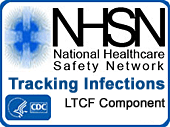

 ShareCompartir
ShareCompartir



